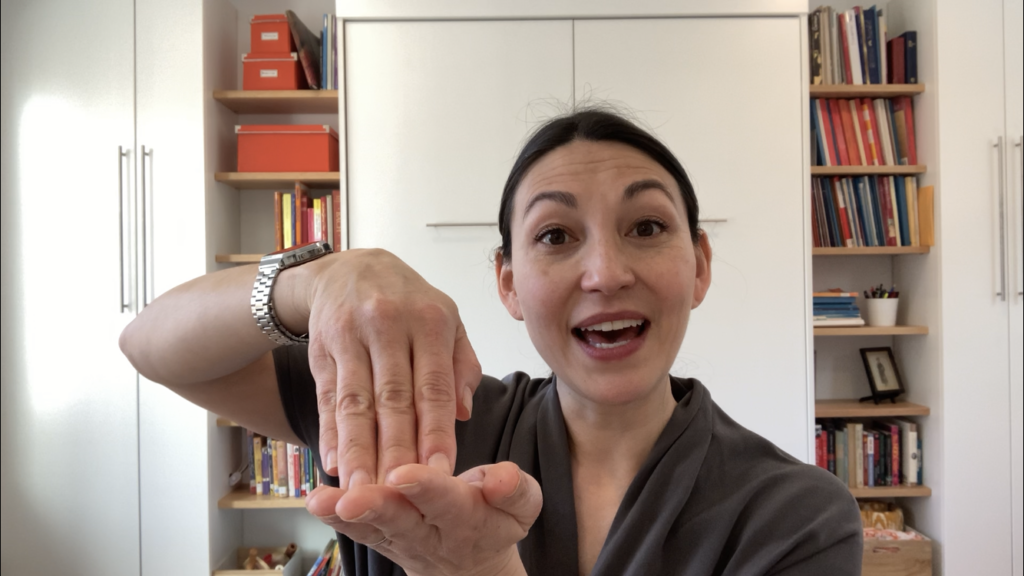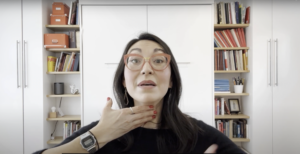Every time I do this exercise in a workshop, it’s a brain-exploding moment. Much like realizing that air comes out of your nose when you’re humming, it’s disarming to identify the things your body parts have been doing without your knowledge all your life. Ready to expand your consciousness? Let’s do the Six Vowels!
The pitches here are very arbitrary, and really, the knowledge portion of this exercise is by far the most important part and can be done speaking or even silently. But for the purposes of having a thing to do while vocalizing, let’s give this the pitches of sol fa mi re do, a downward five note scale. We’ll sing the vowels on the top pitch, sol, and then come down on the final vowel. “Ee-eh-uh-ah-oh-oo-oo-oo-oo-oo.”
Now, get up close and personal with your mouth and follow me in pinpointing what you’re doing in the articulators (lips, tongue, teeth) to make each distinct vowel. Once we identify the actual necessities, we can get rid of the extra stuff that is happening, which is probably just tension or over-efforting.
- “ee”, or in IPA, [i] – say “flea, see, tree, three” and feel what the tongue is doing. The middle sides of the tongue are moving up to touch the upper molars. If you are a person who usually makes “ee” by grinning, try saying those words again and moving the lips all around. As long as the tongue is touching those top molars firmly, you can do whatever you want with your lips. So it follows that you don’t need to spread the lips to make ee. So relax them, and enjoy your new “ee” vowel.
- “eh”/[E] – say “let, get, bet” and feel what the tongue is doing now. Still contacting the upper teeth, but with less pressure, wider, and farther back. The tongue is fairly angled here, as in “ee”, sloping downward from back to front. Go back and forth a few times, “ee-eh-ee-eh.”
- Now let the tongue drop all the way down to the bottom of the mouth, nice and relaxed, and make a noise. Did you think you would hear “ah?” Was it an “ah?” Probably not!!! Probably more of an “uh.” This is the sound called schwa, often called the neutral vowel. It shows up ALL the time in American English as its own vowel, and also often parades about trying to convince people it’s “ah.” So before we find out how to ACTUALLY make “ah,” let’s go “ee-eh-uh” a few times. Tongue is going from high mid-mouth contact to wider farther back contact to no contact.
- It’s “ah” time! “ah” or [ɑ] is made like “uh” BUT WITH A LIFT IN THE HARD PALATE. The old-school way of creating this lift is by imagining biting an apple, and it works. This apple bite idea helps you to lift UP in the mouth, not just drop the lower jaw down, which will always give you a flat-toned, dull “ah.” Bite that apple! Ok, add “ah” to the chain of vowels, passing through “uh” to feel the palate lift: “ee-eh-uh-ah”
- “oh” or [ɔ] is just like “ah” but the lips begin to round. If it looks like “oh”, it will sound like “oh”. Notice what happens in and above the roof of the mouth as you round that upper lip – kind of a lifting, dome-like feeling. Try saying, “MinnesOHta” with a Minnesotan accent and you’ll feel it (although IPA purists, I know that’s closer to closed [o] – go with me here). Now, “ee-eh-uh-ah-oh.”
- “ooh”/[u] is easy – just keep rounding those lips. USE A MIRROR and look for a circle. Not hard circular lips like a terrifying dried apple doll, but just soft human lips in a circle shape. 175% of Americans make their “ooh” vowels with the lips in a sideways oval and it doesn’t sound cute. Ready to do all six vowels? “Ee-eh-uh-ah-oh-oo!”
Ok! Are you exhausted by verbiage? Let’s get to the singing! So, on sol, “ee-eh-uh-ah-oh-oo” and then carry that “oo” down the scale to do.
Observe how the drivers move from the tongue to the palate to the lips. Ee and eh are tongue vowels and oh and oo are lip vowels, and although it’s not usually given a classification, it’s important to remember that ah is a palate vowel to get a nice shine there.
Enjoy! You’re perfect now! Thanks for practicing!



2 Responses